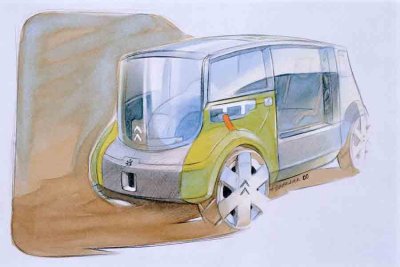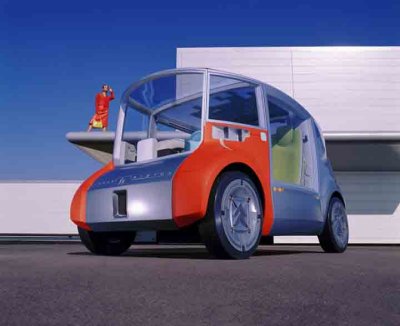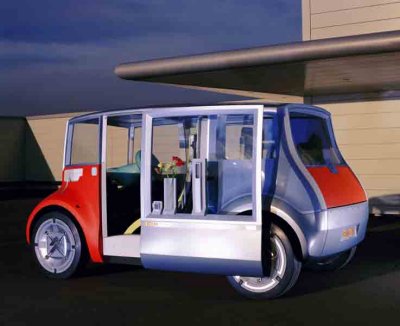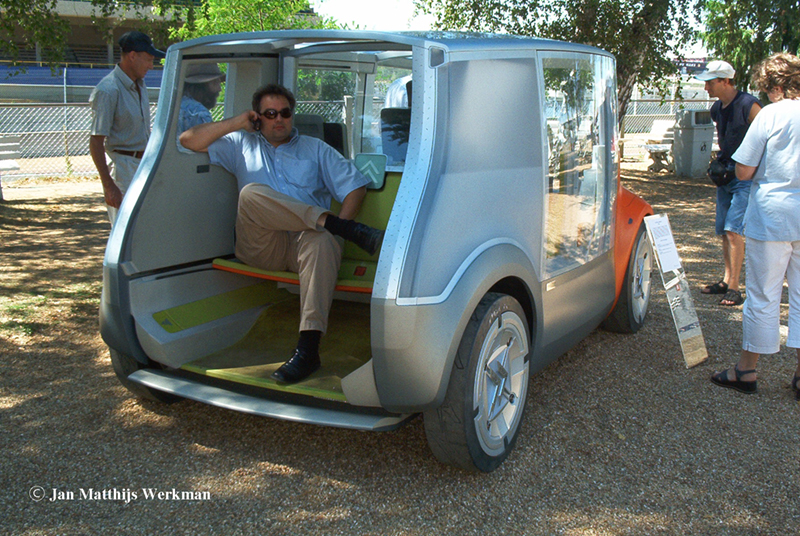|
||||||||||||||||||||||
 |
|
|
The Paris Motor Show will see the birth of Osmose, a bold concept from Citroën which paints a vision of user-friendly vehicle design leading to a new form of relationship between pedestrians and motorists, while addressing the broader issue of responsible car use. Osmose drivers will be able to advertise their journey destination on the side of the vehicle and indicate whether they are willing to pick up pedestrians heading in the same direction. An Osmose can be flagged down like a black cab, or “booked” via WAP phone technology. Each Osmose can carry up to five adults and, as a hybrid, runs in zero emissions mode when in town, where it offers additional pedestrian safety with its external airbags. |
 |
 |
 |
|
The objective is not only to develop a new vehicle concept, but also to address the broader issue of a more responsible mode of usage, open to the outside world, and reflecting the interchangeability of the status of pedestrian and the status of motorist. With the development of Osmose, a passenger car initiating a new form of relations between pedestrians and motorists, Citroën aims to meet this objective and to satisfy all its customer in all circumstances, be they on foot or behind the wheel. Reconciling diverging interests, Osmose sets up a two-way exchange between pedestrians and motorists. In this way, mobility is shared by people who in theory have nothing in common apart from the fact that they happen to be going in the same direction. A natural and fair exchange that respects individual privacy. Osmose can carry three people with luggage in the front part, while the rear part can be transformed to accommodate a further two. The driver can use the right-hand side panel of the vehicle to inform passers-by that he is willing to take passengers and state his destination. If pedestrians see a stationary Osmose, they can attract the attention of the driver or - alternatively - they can use a WAP phone to contact the nearest Osmose travelling to their destination. The vehicle locates the call, and the driver can send back a message of confirmation giving his registration number. Osmose is equipped with a camera-operated retrovision system, transmitting information to the screen in the centre of the steering wheel. The screen also provides traffic information and data concerning the on-board "guests". Before getting on, the pedestrian activates a control function located on the chevrons at the rear of the vehicle. This lets the driver know that somebody is getting on. The tailgate of the Osmose then slides towards the vehicle interior to reveal the rearward facing rear seat - with room for two people - normally stored in the tailgate. An on-board communication system (audio and video) lets the driver and guests hold a conversation during the journey. Before getting out of the vehicle, the passenger can exchange a "virtual handshake" with the host by means of a control function inside the rear compartment. This symbol will then be displayed at the centre of the steering wheel at the same time. Osmose is powered by a hybrid system designed to offer excellent range and to protect the environment with its all-electric Zero Emission Vehicle mode. ZEV mode is used notably for driving through restricted access areas in city centres. Osmose also helps to improve the quality of ambient air. A filter running on solar energy regenerates the air sucked in before discharging it into the atmosphere. Osmose helps the city to breathe. Osmose features quiet, harmonious styling. The car is compact and easy to handle with a height (1.70 m) that suggests a friendly, welcoming character. The vehicle is fitted with two sliding side doors and a tailgate sliding towards the interior to make room for two guests. The
interior design places the focus on nature, with a colour
scheme in
green and brown and a leaf print on the translucent roof that
throws
shadows onto the floor of the vehicle. These leaf forms are
actually
sun sensors, used to power the filter that recycles the air
intake. |
|
 |
 |
 |
The
original and ergonomic layout of the driver's station reflects
the use
of new technology and electrical control systems (steering,
brakes,
accelerator, etc.). The driver's seat is located in the
middle, with
the two folding passenger seats placed slightly back on either
side. Osmose is particularly well suited to urban lifestyles and urban travelling. It heralds a new age in the relations between man and the car. |
 |
|
 |
|
| © 21 September 2000 Julian Marsh/Citroënët/SA Automobiles Citroën/Jan Matthijs Werkman | |

